Related Research Articles

Tripe is a type of edible lining from the stomachs of various farm animals. Most tripe is from cattle, pigs and sheep.
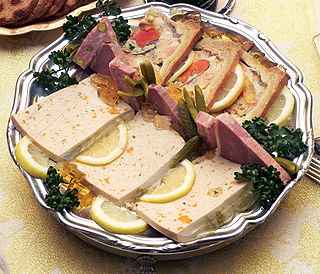
Offal, also called variety meats, pluck or organ meats, is the organs of a butchered animal. The word does not refer to a particular list of edible organs, which varies by culture and region, but usually excludes skeletal muscle. Offal may also refer to the by-products of milled grains, such as corn or wheat.
Jamaican cuisine includes a mixture of cooking techniques, flavours and spices influenced by Amerindian, African, Irish, English, French, Portuguese, Spanish, Indian, Chinese and Middle Eastern people who have inhabited the island. It is also influenced by the crops introduced into the island from tropical Southeast Asia, many of which are now grown locally. A wide variety of seafood, tropical fruits and meats are available.

Callaloo is a popular Caribbean vegetable dish. There are many variants across the Caribbean, depending on the availability of local vegetables. The main ingredient is an indigenous leaf vegetable, traditionally either amaranth, taro leaves or Xanthosoma leaves.

Oxtail is the culinary name for the tail of cattle. While the word once meant only the tail of an ox, today it can also refer to the tails of other cattle. An oxtail typically weighs around 3.5 kilograms and is skinned and cut into shorter lengths for sale.
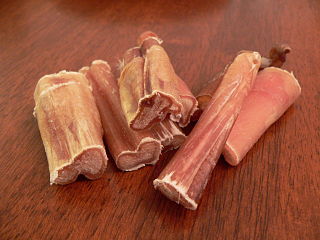
Pizzle is a Middle English word for penis, derived from Low German pesel or Flemish Dutch pezel, diminutive of pees, meaning 'sinew'. The word is used today to signify the penis of an animal, chiefly in Australia and New Zealand.
Soup Number Five, variously spelled Soup No. 5 or Soup #5, is a soup made from bull's testes or penis. The dish originates from Filipino cuisine. It is believed to have aphrodisiac properties.

Mannish water is a goat soup in Jamaican cuisine. It is believed to be an aphrodisiac and is made from various goat parts.
Red peas soup is a soup eaten in Jamaica. It is made of kidney beans, seasonings such as scotch bonnet pepper, pimento seeds, etc. Traditionally, the broth includes a pigtail. Red Peas Soup is usually eaten with yam and Jamaican dumplings.
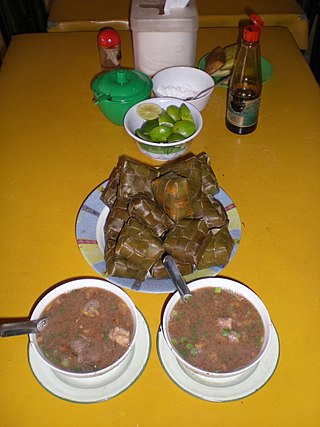
Coto Makassar or Coto Mangkasara (Makassarese), is an Indonesian traditional soup originating from Makassar, South Sulawesi. It is a variant of soto traditional beef and offal stew with seasoned broth made from ground peanuts and spices. The main ingredient of this soup is beef and it can be mixed with innards such as intestine, liver, lungs, heart, tripe, or cow brain.

Bermuda fish chowder is a chowder soup that is considered the national dish of Bermuda. Its basic ingredients are fish, tomatoes and onions, seasoned with black rum and "sherry peppers sauce". The recipe is believed to have been developed by the 17th century British colonizers of Bermuda.

Mordovian cuisine is the traditional cuisine of the Mordovians, who now live in Mordovia and surrounding areas. It consists of a variety of dishes, based on geographical, cultural and climate features of the region, with fish traditionally featured heavily.

Run down, also referred to as rundown, run dun, rondón, fling-me-far, and fling mi for, is a stew dish in Jamaican cuisine and Tobago cuisine. The traditional Jamaican dish is eaten in several Latin American countries that share a coast with the Caribbean Sea.
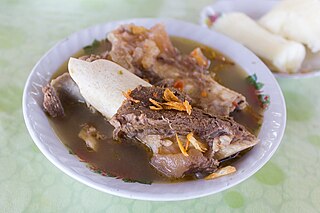
Kaledo is a traditional cow's trotters soup served in spicy broth, from Donggala regency, Central Sulawesi, Indonesia. Per its name, the meat used in this particular food is cow's feet and its marrow. The dish originated from Donggala, and from there spread around Sulawesi.
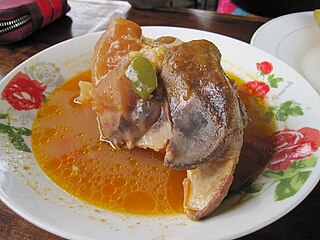
Cow's trotters are the feet of cattle. The cuts are used in various dishes around the world, especially in Asian, African, French, and the Caribbean cuisine. Latin American cuisine also uses cow's trotters for several traditional dishes.

Eru is a soup from Cameroon. It is a specialty of the Bayangi people, of the Manyu region in southwestern Cameroon. It is vegetable soup made up of finely shredded leaves of the eru or okok. The eru is stewed with waterleaf or spinach, palm oil, crayfish, and either smoked fish, cow skin (kanda) or beef.

Callos a la Madrileña is a stewed tripe dish, cooked slowly for hours over low heat, that is a speciality of Spanish cuisine associated with the city of Madrid. Traditionally pig or cow tripe was used but modern recipes use lamb or even cod. It includes pig snout and trotters, black pudding, sausage, ham, and soup vegetables like carrots and onions. When prepared correctly the broth is rich in gelatin and the tripe becomes very tender after the slow cooking process. The tripe can be browned before the cooking liquid is added, with trotter's, oxtails and other ingredients for the soup like ham, chorizo and smoked paprika. It is common to serve this stew with the morcilla blood sausage, a tapas dish typical of the region of Castile and León.
References
- ↑ Polly Thomas, Adam Vaitilingam, Polly Rodger Brown The rough guide to Jamaica page 38
- ↑ Richard Allsopp Dictionary of Caribbean English Usage